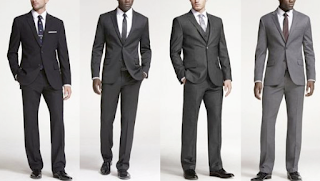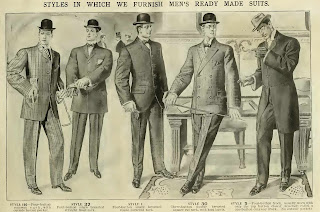"You cannot climb the ladder of success dressed in the costume of failure."
-Zig Ziglar
 From the debonair tuxedos of James Bond to the fiercely understated skinny ties and black suits of Mad Men, three-piece buttoned-up Presidential hopeful Donald Trump or even the beloved Clark Kent before his phone booth transformation to Superman, everyone loves the business suit. Classic, powerful, confidence-inspiring and sometimes sexy, there really is no greater tool in the world of business than a refined and well-dressed man or woman.
From the debonair tuxedos of James Bond to the fiercely understated skinny ties and black suits of Mad Men, three-piece buttoned-up Presidential hopeful Donald Trump or even the beloved Clark Kent before his phone booth transformation to Superman, everyone loves the business suit. Classic, powerful, confidence-inspiring and sometimes sexy, there really is no greater tool in the world of business than a refined and well-dressed man or woman. Today, we'll celebrate and explore the history of business suits, as a few universal and time-tested rules for wearing one to perfection.
1. The word suit
come from the French word suite, which means "following", from
some late Latin derivative form of the Latin verb sequor = "I
follow", because the component garments (jacket and pants and vest) follow
each other and have the same cloth and color and are worn together.
2. Originating
in the United Kingdom as ‘country wear’, suits are now an ever popular part of
every professional’s closet across America.
3. There are several different variations of
design, cut, and cloth, such as: single and double breasted, two- (jacket and
pants) and three-piece (jacket, pants, and vest). These variations define
whether the garment is suitable for social or work environments. Typically, the
more conservative the color and cut, the more suited it is for the workplace.
4. Originally, as with most clothes, a
tailor made the suit from his client's selected cloth; these are now often
known as ‘bespoke’ suits. The
suit was custom made to the measurements, taste, and style of the man.
5. Until around the
1960s, as with all men's clothes, a hat would have also been worn when the
wearer was outdoors. God forbid today’s man would have to mess up their S.E.C.
swoop.
6. Since the Industrial Revolution,
most suits are now mass-produced, and, as such, are sold as ready-to-wear
garments (though alteration by a tailor prior to wearing is common). The Brooks
Brothers Company first introduced these ready-to-wear suits. Currently, suits
are sold in roughly four ways:
•
bespoke, in which the
garment is custom-made by a tailor from a pattern created entirely from the
customer's measurements, giving the best fit and free choice of fabric;
•
made to measure, in which a
pre-made pattern is modified to fit the customer, and a limited selection of
options and fabrics is available;
•
ready-to-wear, or
off-the-rack, which is sold ready to be tailored, or finally as
•
suit separates, where the coat
and pants are sold separately allowing a customer to choose the size that is
best for them and limit the amount of alterations needed.
7. The current styles
were founded in the revolution during the late 18th century that sharply
changed the elaborately embroidered and jeweled formal clothing into the
simpler clothing of the British Regency period, which gradually evolved to the
stark formality of the Victorian era. It was in the search for more comfort
that the loosening of rules gave rise in the late 19th century to the modern business
suit that is popular in America today.
8.
In the U.S. people often wear a suit to a job interview. The best bet for
wearing a suit to an interview, is to go for a conservative style that is
either grey or navy blue. Of course the level of conservatism can change
depending on the organizational culture of the industry in which you’re
interviewing. Interview suits are usually composed of wool or a wool-blend
fabric that is a solid color, or has a fine pin stripe pattern.
9. Men’s suits have become far less common as an outfit of daily wear in
modern society. During the 1990’s, driven in part by the meteoric rise of newly
successful technology companies with different cultural attitudes, the
prevailing management philosophy of the time moved in favor of more casual
attire for employees; the aim was to encourage a sense of openness and
egalitarianism.
10. "Business casual" dress still tends to be the
norm for most workers up to and sometimes including mid-level management.
Traditional business dress as an everyday style is generally limited to middle-
and upper-level corporate management (now sometimes collectively referred to as
"suits"), and to the professions (particularly law).
11.
Suit-wearing etiquette for women generally follows the same guidelines used by
men, though they have more flexibility in terms of style and color than men do.
12.
For women, the dress suit or skirt suit are both acceptable; a blouse, which
can be white or colored, takes the place of a dress shirt. Women's suits can
also be worn with colored tops or T-shirts.
13.
Women generally do not wear neckties with their suits. Fancy silk scarves that
resemble a floppy acsot tie became popular with women in the U.S. in the 1970’s.
14.
By the 1980’s, women were entering the white-collar workforce in increasing
numbers and their dress fashions adopted looks that were more similar to that
of their male counterparts in the business world.
15.
By the early to mid-1980s, conservatively tailored skirt suits were the norm,
in the same colors and fabrics considered standard in men's suits. These were
typically worn with buttoned-up collared blouses, usually white or some pastel
in color.
Do-
16. Get your pants taken
up if they gather at the point where they meet your shoes. Ideally, pants
should break on top of your footwear, or sit just above it.
17. Make sure your jacket
tapers at the waist to help accentuate your shoulders, regardless of how big
they are.
18. Ensure your jacket
sleeves sit at the top of your wrists. This will allow for a quarter to half an
inch of shirt cuff to show.
19. Always go for a
classic cut, rather than a contemporary. Navy blue or charcoal grey are your
best bets when buying your first suit, as its versatility will mean you’re able
to get plenty of wear from it.
20. Buy yourself two
pairs of pants if you plan on wearing your suit to work everyday, as they’ll
often wear out before the jacket does.
Don’t-
21. Don’t ever do up the
bottom button on a two or three-button suit.
22. Don’t get your suit
dry-cleaned too often, as the chemicals used in dry cleaning will eventually
cause your suit to wear out and go shiny.
23. Don’t try and be too
flashy with your footwear. It’s best to stick with a traditional pair of
classic Oxfords or penny loafers, as the wrong choice can instantly destroy the
impact of a well-cut and composed suit.
24. Don’t leave the brand
label on your jacket sleeve, regardless of where you bought it.
25. Don’t think knowing a
good tailor is inconsequential, as the odd tweak here and there can make a $175
suit look like a $1,750 suit.




Very well explained on Mens Corporate Suit Thank you for sharing this article with us...
ReplyDeleteLewis
Considering the professional side, event management is a glamorous and exciting profession that requires a lot of hard work and enthusiasm. But only a few universities offer diplomas in corporate event planning, event management and organizational skills.
ReplyDeleteThanks for featuring such a great collection of custom tailored suits for men. Choosing any of these stylish suits will add an extra bit of glamour and style. I would surely love to read more articles related to men's fashion and other formal wears. Do keep writing. Kudos to your work.
ReplyDeleteThe tailored three piece suit esis wearing since the 19th centuries and still everyone likes it so much in movies and functions. It is very classic and comfortable design like to try the three piece suit.
ReplyDelete